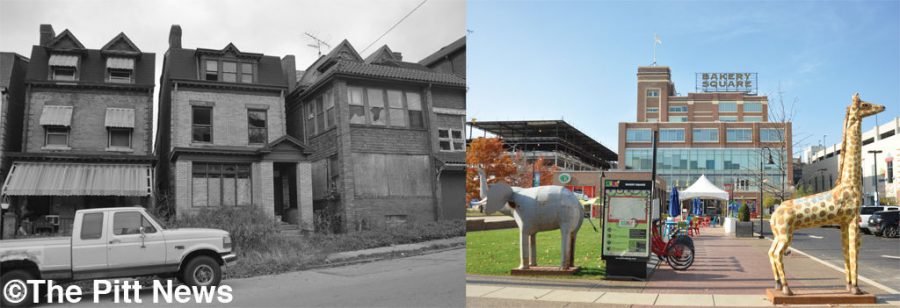Neighborhoods in transition: Gentrification hits Pittsburgh
November 13, 2014
Daniel Stavros of Braddock said Pittsburgh still hasn’t recovered since the city’s steel mills barred their doors.
“Even after all this time, we still see many people struggling to make ends meet, and the neighborhood I live in is still doing pretty poorly many years later,” Stavros, 56, said.
Pittsburgh used to be a premier industrial town. According to a report from Carnegie Mellon University’s Institute for Complex Engineered Systems , steel mills laid off 153,000 workers following the 1981-82 depression. By 1990, seven of Pittsburgh’s nine major steel plants were closed.
According to the Center for Disease Control and Prevention, gentrification is the “transformation of neighborhoods from low value to high value.”
The CDC wrote on its website that gentrification can displace long-time residents because of higher rents, mortgages and property taxes, which affects a community and social capital on a historical and cultural level.
Stavros highlighted stark differences in Pittsburgh’s working class communities to show that there is hope for change coming.
“Look at neighborhoods that only a few years ago weren’t doing so well,” he said. “Today some of those very same neighborhoods are thriving.”
While gentrification often comes with negative social stigma, Daniel Hartley, a research economist for the Federal Reserve Bank of Cleveland, used data to suggest gentrification has measurable health benefits.
Using census data, Hartley found that 7 percent of Pittsburgh’s low-price housing tracts experienced gentrification between 2000 and 2007.
Hartley also found that, when using individual Equifax risk scores, living in one of the gentrified neighborhoods correlated to an estimated eight-point increase in credit scores, as compared to a low-price, ungentrified neighborhood.
In Pittsburgh, change has come for a variety of reasons. Stavros credited the Pittsburgh-owned restaurants and retailers.
Five of Pittsburgh’s “33 best restaurants,” awarded annually by Pittsburgh Magazine, are located in the East Liberty and Lawrenceville neighborhoods, areas which struggled economically in the past.
“Look at neighborhoods, like Lawrenceville and East Liberty, that are filled with most of Pittsburgh’s best-known restaurants, and from there stems other better businesses and families moving in,” Stavros continued.
Nadia Allen, 29, of Lawrenceville said her neighborhood’s change is amazing to watch.
“I moved into Lawrenceville just after I graduated college seven years ago,” she said. “And now I look at what a wonderful place it has become. It is affordable, there are many amazing restaurants and coffee shops within walking distance of my home and art shows that are great to check out on a bike ride.”
Allen said her favorite street in Pittsburgh is Butler Street in Lawrenceville, because every day there is something different happening.
Art All Night, an annual summer event in Lawrenceville, brings artists from all over the region for the enjoyment of the residents of the neighborhood, while new businesses, such as Phoenix Upscale Consignment Boutique and La Gourmandine Bakery & Pastry Shop, line Butler Street.
Allen said she is supportive of the process of gentrification, but only if it benefits those living in the community and Pittsburgh as a whole.
“Gentrification has a history of pushing out those who can no longer afford living in the area or neighborhood because of how ridiculously high housing prices can rise,” she said.
East Liberty resident Janae Walker, 32, said she has conflicting feelings on the changes.
Several of Walker’s friends and family members were forced to move out of the neighborhood because they could not longer afford to live in the neighborhood after housing prices increased over time.
“It’s just ridiculous,” Walker said. “I know so many people who were pushed out, and this is their home.”
At the same time, though, Walker said she is doing better as a businesswoman in the neighborhood because the increase in interest in the neighborhood.
“I own a salon, and, with more people coming here, it has definitely increased my clientele,” Walker said.
East Liberty began to develop commercial chain retailers in 1999 when Home Depot opened and continued when Whole Foods Market opened in 2002, according to the 2010 East Liberty Community Plan, available at eastliberty.org. Since then, more chains began to open, including Starbucks, Walgreens and others, which have contributed to the neighborhood’s economy and traffic.
Amid mixed reactions of neighborhood change in two of Pittsburgh’s most popular and busy neighborhoods, the people of Pittsburgh turn their gaze to other neighborhoods.
“I think that people in Pittsburgh believe that this kind of change is wanted in every neighborhood,” Jason Smith, a resident of Braddock, said. “I don’t think that every neighborhood in the city wants to become Lawrenceville or East Liberty or Shadyside.”
However, Smith said he does “welcome some change in Braddock,” particularly the business plans of Kevin Sousa.
Sousa is an award-winning Pittsburgh chef and entrepreneur who plans to open a restaurant, known as “Superior Motors,” in Braddock using more than $300,000 raised using a Kickstarter campaign.
Sousa previously opened Union Pig and Chicken and Station Street in East Liberty, and Salt of the Earth in Garfield, but sold his portion of ownership of Salt at the end of last year.
Sousa could not be reached for comments after multiple requests over email and calls to his restaurants.
“I think its fantastic what he [is] doing for the neighborhood,” Smith said.
Braddock has also seen an art gallery open in recent years. Many of the initial things that changed Lawrenceville are beginning to bud in Braddock.
“Good art and good food attracts good people,” Stavros said. “At least, that is what I think should happen.”



